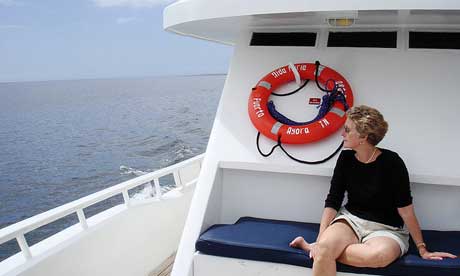
Try jam-sarnies, avoid radishes and cucumbers, and keep your eyes locked on the horizon
Some people always get seasick, others it might take by surprise – but few of us are wholly immune to its effects if the conditions are bad enough. It’s a distressing and depressing state, and could deter you from some of the world’s greatest travel experiences – the idea of spending most of an Antarctic expedition or Galápagos cruise with your head down the toilet might persuade you to choose an alternative, land-based adventure.
But you don’t have to forgo watery travel: understand more about the condition – why it exists and how to treat it – and you could soon be setting sail.
Motion sickness is caused by a mismatch of signals arriving in the brain. Under normal circumstances the semicircular canals within your inner ears tell you which way up you are.
The canals are filled with fluid containing tiny lumps of chalk, which settle under gravity. When the chalky lumps touch sensory hairs lining the canals a signal is sent to the brain, informing it whether you’re vertical or horizontal.
However, in rough seas the lumps get thrown around and stimulate sensory hairs that aren’t at the lowest point in the canal system. This is confusing. When the sufferer’s eyes then tell their brain something at odds with what the balance organs in the ear are saying, dizziness, unsteadiness, often nausea and sometimes vomiting strike.
This can come on quite suddenly, but often the nausea creeps up more slowly. It may be preceded by yawning – a helpful warning to parents. Next, people tend to go pale and feel clammy, their salivation increases and, finally, they vomit. Vomiting often makes people feel better for a while but if the sensory mismatch continues, further vomiting is likely; this can progress to distressing dry retching.
This miserable state may condition you to feel nauseated when you detect certain smells (such as ships’ diesel or wafts emanating from the galley) and is exacerbated if people are vomiting around you – unfortunately motion sickness is one of those conditions where a mere suggestion of it can make the symptoms come back: there is a significant psychological element to the condition, which is very hard to combat.
There are several poor design features in human physiology that make seasickness difficult to treat. Firstly, once the feeling of nausea has come upon the victim, swallowing pills doesn’t usually help. Nausea suggests that substances are no longer being absorbed from the stomach – they just sit and churn there. Whatever has been swallowed will float around uselessly in the stomach’s contents.
At this stage the belly feels full and bloated; sometimes you are even aware of fluid slopping around in the stomach. This excess fluid is the stuff the body rejects in motion sickness.
This means that if you are prone to motion sickness, you must dose yourself well before the motion starts to upset you. Note that the instructions on sea sickness pills often don’t tell you to dose early enough: with antihistamine preparations it may be necessary to take a pill three hours ahead of the journey or even the night before, with a top-up dose in the morning.
If you haven’t been organised enough to dose up before starting to feel ill, then hyoscine is the drug most likely to work. Melt-in-the-mouth preparations are even partially absorbed through the mucous membranes of the mouth rather than through the stomach lining. The downside of hyoscine, however, is that taking a second or third dose is likely to cause an unacceptable level of side effects (dry mouth, dizziness, even blurred vision). Once the nausea is under control, then, an antihistamine should be used to prevent further vomiting.
Perhaps surprisingly, clinical trials have established that ginger is highly effective in treating nausea and vomiting; it works as well as the established anti-emetic metoclopramide (Maxolon), which is widely prescribed for morning sickness. A ‘dose’ of ginger would be one gram of ginger extract in tablet form or a handful of fresh root ginger. Travel with ginger in a form you like – for example, crystallised or as biscuits or wine.
To help keep nausea at bay, eat light, non-greasy foods in small portions, but avoid cucumber and radish, which slow emptying of the stomach into the intestine.
Don’t drink large volumes of fluids – they’ll slop around in your stomach – but don’t keep the stomach empty or you may start dry retching. Strawberry jam sandwiches are good ‘seafood’ – they taste as good coming up as going down!
Travel bands – wristbands that push down on certain pressure points – help some people. You could also try distracting yourself with music (though avoid reading) and lying down with your eyes shut – it removes one set of confusing signals to an already baffled brain.
Find the place that moves the least – on a ship this is middle decks, amidships. Going up on deck for some fresh air can help; look at the horizon rather than at things nearby. Lastly, if you are going to vomit, spit first to check which way it will blow.
Dr Jane Wilson-Howarth gets nauseated easily; her favourite seasickness pill is Stugeron. For more information, see www.wilson-howarth.com